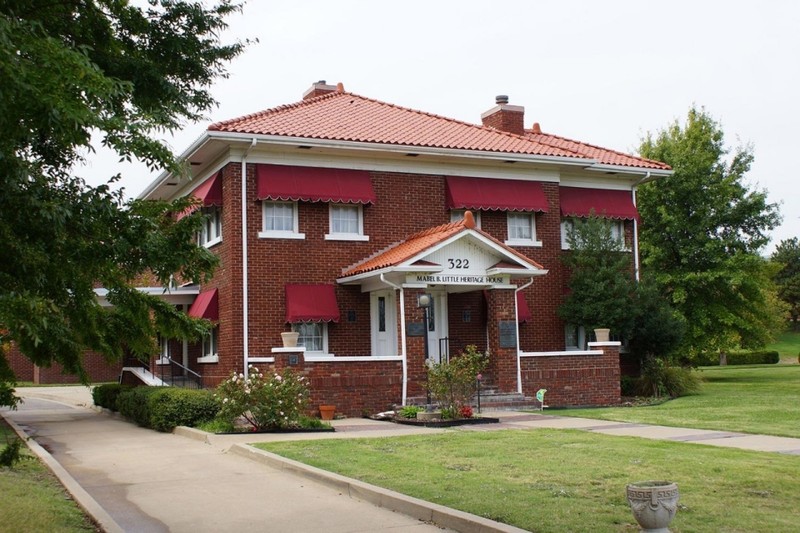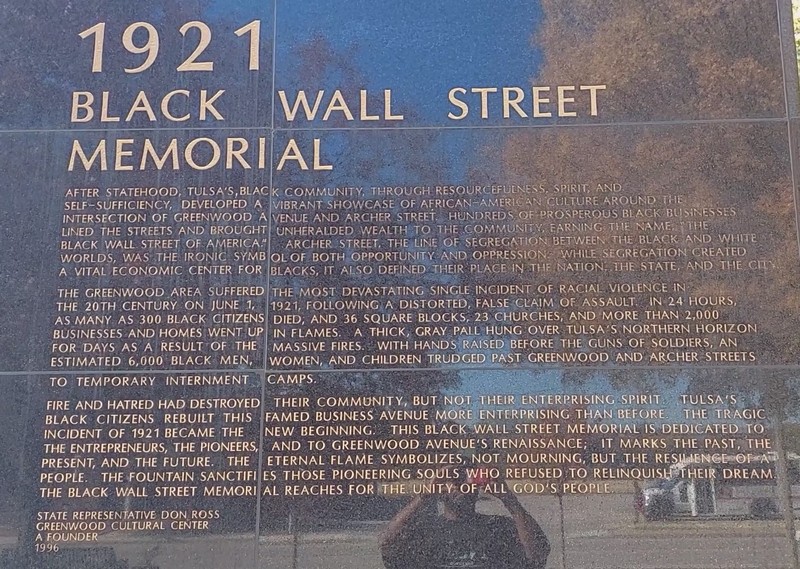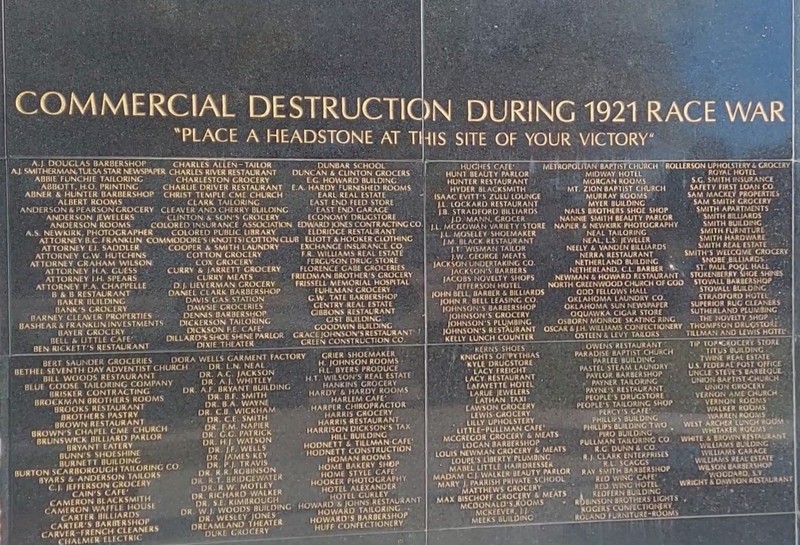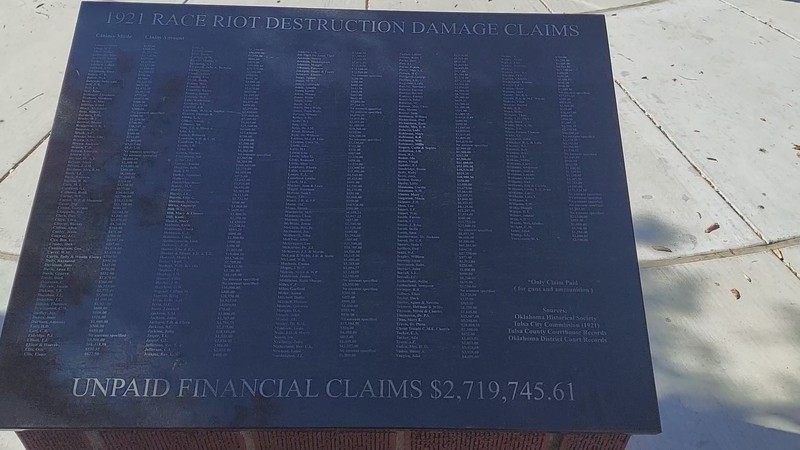Mabel B. Little Heritage House (Part of the Greenwood Cultural Center Complex)
Introduction
Text-to-speech Audio
The Greenwood Cultural Center is open to the public. Entry is free, but donations are accepted. There are historic photos, newspaper clippings, and other artifacts from Greenwood before, during, and after the 1921 Tulsa Race Massacre throughout the building. They will often have a film playing and seating for a group to sit and watch. There are books and other items about Greenwood and the Tulsa Race Massacre available for purchase in the administration office. The Greenwood Cultural Center is open Monday through Friday 9 a.m. to 5 p.m.
The Mabel B. Little Heritage House in Tulsa, Oklahoma, is part of the larger Greenwood Cultural Center complex. The home is a testament to the rich history of Tulsa’s African- American community and its powers of resilience. Originally built by the Sam and Lucy Mackey family of Tulsa, Greenwood designated the historic home as a museum to honor the legacy of African-American community leader and activist Mabel B. Little and the victims claimed by the 1921 Tulsa Race Riot. The Mabel B. Little Heritage House Museum is next to the cultural center and shares the same address. It is the only surviving home from the 1920's in the Greenwood area. It was built in 1925 by Sam and Lucy Mackey, survivors of the 1921 Tulsa Race Massacre. Their original home was completely destroyed by fire during the massacre. It is a beautiful home that shows how many Black residents in the Greenwood area of Tulsa lived. The Mabel B. Little Heritage House days and hours are limited. Please call ahead for current open days.
The Black Wall Street mural is across the parking lot from The Greenwood Cultural Center. On the property of the cultural center is the "1921 Black Wall Street Memorial" carved in beautiful Black stone memorial. It was erected 75 years after the massacre. There is also a slab that details the unpaid insurance claims and the people that requested them. There was only one claim that was paid - to a white store owner for stolen guns and ammunition.
Images
Mabel B. Little Heritage House

Black Wall Street mural, across the parking lot from the Greenwood Cultural Center.

1921 Black Wall Street Memorial

1921 Black Wall Street Memorial

Insurance claims made by victims of the Tulsa Race Massacre. All claims but one were denied. The approved claim was for guns and ammunition stolen from a white store owner.

Backstory and Context
Text-to-speech Audio
Fashionista, stylist, and entrepreneur Mabel B. Little moved to Tulsa from the all-Black town of Boley, Oklahoma in 1913. The granddaughter of slaves, Little moved with her ailing mother to the city in hopes of better supporting her. Within the first year of her arrival in Tulsa, Mabel met and married restauranteur Presley Little. Between 1918 and 1927, the Littles adopted 11 children, many of whom were extended family members. Besides their own burgeoning brood, the Little family was also well-known for helping other needy children in the Greenwood neighborhood. Presley died a month after the last of the children came to live with the family, leaving Little to raise her family alone. Little persevered, and eventually adopted a twelfth child on her own in 1940.
Little’s first job was working at the Brady hotel for $20 per month. By 1915, Little began a side business of washing, setting, and waving hair using skills taught to her by her aunt. In 1917, Little opened the Little Rose Salon, which was the first establishment in Tulsa that catered to African-American beauty needs. Thursday nights saw her shop filled with young women being beautified, as Thursday was the customary “Maid’s Night Out,” the one night each week that young African-American domestics working in white homes had off. Little’s salon was destroyed in the fires of the Riot, but she rebuilt it. During the Great Depression, Little uprooted her salon and followed the aviation boom west, moving first to Wichita, Kansas and eventually to Los Angles. Eventually Little returned to Oklahoma, where she lived until her death in 2001. She had lived to be 104 years old and spent the majority of her days as a leader and advocate for her beloved Greenwood community.
The house is worth mention in its own right because of its important symbolic meaning to the Greenwood community. It is the only home built in the 1920’s which still stands in the Greenwood District. Grounds keeper Sam Mackey and domestic Lucy Mackey worked for wealthy employers living in the elite Maple Ridge neighborhood. They were a working-class couple who managed to build such a fine home in Greenwood that it rivaled its counterparts in the elite white neighborhoods. The Mackeys built it to show their community that Greenwood could also build magnificent things in their community. Their original structure, located at 327 North Greenwood, was burned to the ground during the Riot. The Mackeys escaped because Barney Cleaver, Tulsa’s only African-American police officer, warned the neighborhood that the armed, fire-wielding white mobs were coming. The original home, along with 36 city blocks, were burned to the ground during the Riot.
After the Riot, the Mackeys built a new stately home at 322 North Greenwood, this time choosing fire-proof masonry instead of the combustible wood frame construction of their previous home. Like every other Greenwood homeowner, the Mackeys discovered that the home insurance they’d been paying refused to cover rebuilding costs because their policies contained no “riot clause.” In order to rebuild, the community shared, sacrificed, and pooled their resources. Some institutions in Oklahoma City were willing to lend money for the rebuilding process.
Though the record is unclear as to the architect's name, the Mackeys hired one of Tulsa’s most talented designers for their new home. The stunning design won a $1,000 prize for architectural design. Three-way lighting switches and walk-in closets were among the home’s unusual architectural features. For decades, the home served the Greenwood community as a site for special occasions, social functions, and community gatherings. Today, the site houses a collection of artifacts and memorabilia of pre-Riot Greenwood, exhibits about the Riot, and information about Mabel B. Little and the Mackeys.
Sources
Hirsch, James. Riot and Remembrance: America's Worst Race Riot and Its Legacy. New York: Mariner Books, 2003. Print. Johnson, Hannibal B. Tulsa's Historic Greenwood District . Mount Pleasant, SC: Arcadia Publishing, 2014. Print. Little, Mabel B., with Nathan and Julia Hare. Fire on Mount Zion : My Life and History as a Black Woman in America. Langston, OK: Langston University Press, 1990. Print.
Photo courtesy of Al Jazeera news
Photo by Vee Spikes II
Photo by Vee Spikes II
Photo by Vee Spikes II
Photo by Vee Spikes II
